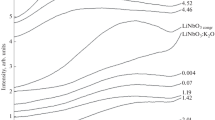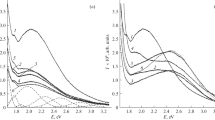Abstract
IN the first papers on the electroluminescence of gallium phosphide1, photographs of the emission spectra of undoped and zinc-doped crystals were observed to differ. As a working hypothesis, Wolff, Hebert and Broder1 suggested that zinc might form a luminescent centre in gallium phosphide analogous to copper in zinc sulphide. Carrying this analogy further, they proposed that the zinc centres are ionized by impact with charge carriers injected at the negative electrode (the luminescence in most cases originated at the negative electrode). Since this work was reported, several workers2–5 have observed electroluminescence at grain boundaries in gallium phosphide polycrystals and have proposed p–n junction recombination to be the dominant luminescent mechanism. Grimmeiss and Koelmans3 report that undoped or weakly zinc-doped electroluminescing polycrystals can be shown to contain both p- and n-type regions (they were mainly n-type) and all give the same emission spectrum. Heavily zinc-doped samples were uniformly p-type and did not electroluminesce. I have investigated the electroluminescence of gallium phosphide single crystals of uniform conductivity type and find the emission spectrum from undoped n-type crystals to be similar to that reported by Grimmeiss and Koelmans. Weakly zinc-doped crystals, however, are p-type (1017 carriers/c.c., 50 cm.2/V. sec. mobility, from Hall effect measurements) and give a unique electroluminescence emission which is probably the same as that observed by Wolff et al. (The ‘zinc’ electroluminescence has also been observed by M. Gershenzon (private communication).) Heavily zinc-doped crystals are darker in colour and do not electroluminesce, in accord with the observations of Grimmeiss and Koelmans.
Similar content being viewed by others
References
Wolff, G. A., Hebert, R. A., and Broder, J. D., Phys. Rev., 100, 1144 (1955); Semiconductors and Phosphors, 547 (Interscience, 1958).
Holt, D. A., Alfrey, G. F., and Wiggins, S. S., Nature, 181, 109 (1958).
Grimmeiss, H. G., and Koelmans, H., Philips Res. Rep., 15, 290 (1960).
Gorton, H. C., Swartz, J. M., and Peet, C. S., Nature, 188, 303 (1960).
Allen, J. W., and Gibbons, P. E., J. Elec. Control, 7, 618 (1959).
Patrick, L., and Choyke, W. J., J. App. Phys., 30, 236 (1959).
Author information
Authors and Affiliations
Rights and permissions
About this article
Cite this article
ULLMAN, F. Electroluminescence of Gallium Phosphide Crystals. Nature 190, 161–162 (1961). https://doi.org/10.1038/190161a0
Issue Date:
DOI: https://doi.org/10.1038/190161a0
- Springer Nature Limited





